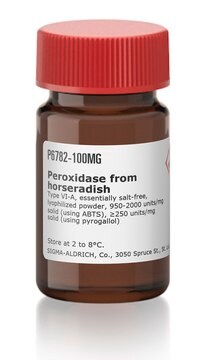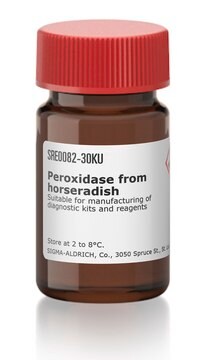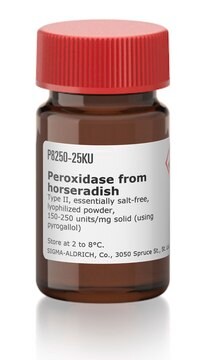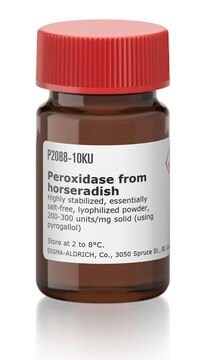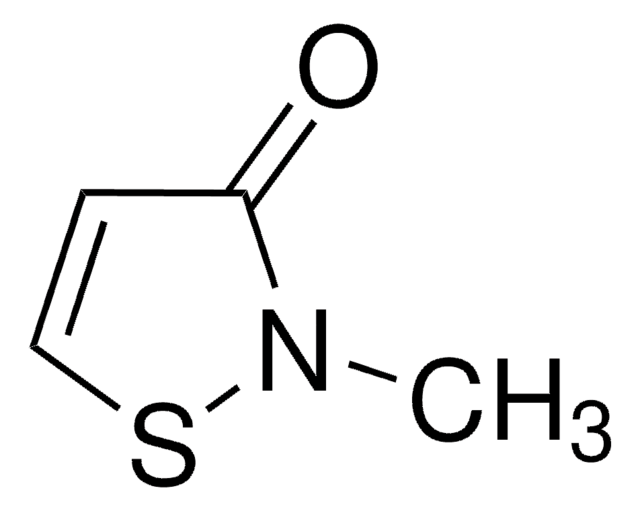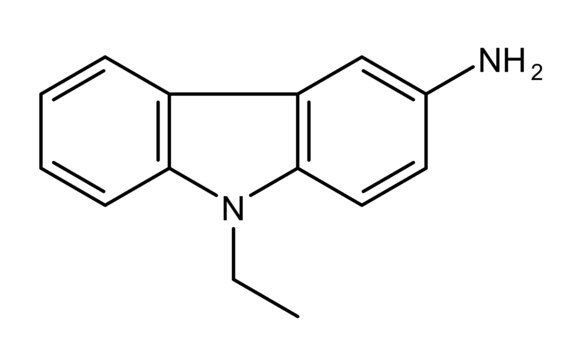Kluczowe dokumenty
11829696001
Roche
Zestaw do znakowania peroksydazą
sufficient for 5 labeling reactions, kit of 1 (7 components), suitable for ELISA, suitable for immunohistochemistry
Synonim(y):
Peroksydaza
About This Item
Polecane produkty
zastosowanie
sufficient for 5 labeling reactions
Poziom jakości
aktywność właściwa
800 U/mg (800 U/mg protein at +25°C and pH 5.0 with ABTS and H2O2 as substrates.)
800 units/mg protein (At 25 °C and pH 5.0 with ABTS and H<sub>2</sub>O<sub>2</sub> as substrates.)
opakowanie
kit of 1 (7 components)
producent / nazwa handlowa
Roche
metody
ELISA: suitable
immunoblotting: suitable
immunohistochemistry: suitable
temp. przechowywania
2-8°C
Opis ogólny
Specyficzność
Isoenzyme distribution: > 90% homogeneous isoenzyme C.
Assay Time: The procedure is developed for a reaction temperature of +25°C. At +25°C the reaction time should be 2 hours but it can be extended to 3 hours without influencing the results. Alternatively, the reaction can be carried out at +2 to +8°C with a reaction time of 18 hours up to 24 hours.
Zastosowanie
- ELISA (enzyme-linked immunosorbent assay)
- immunohistochemistry
- immunoblotting
Cechy i korzyści
- Fast - the whole labeling procedure can be performed in one day
- Easy - only 5 simple working steps
- Complete - all necessary buffers and reagents are supplied with the kit
Opakowanie
- Peroxidase (activated)
- Sodium Carbonate/hydrogen Carbonate Buffer
- Sodium Borohydride (tablets)
- Triethanolamine Buffer
- Glycine Solution
- Dialysis Buffer
- Stabilizing Agent (includes BSA and Kathon CG)
Uwaga dotycząca przygotowania
For best results, mark each solution with the appropriate number. Volumes indicated are sufficient to label a portion of 1.2 mg IgG.
Solution 1: Peroxidase (activated)
Reconstitute the lyophilizate of bottle 1 in 0.5 ml double-distilled water (peroxidase concentration = 16 mg/ml).
Solution 2: Sodium Carbonate/-hydrogencarbo-nate Buffer (100 mM, pH 9.8)
Equilibrate bottle 2 to 15 to 25 °C. Be sure that all buffer components are dissolved. Add 10 ml of bottle 2 to 90 ml double-distilled water, mix well.
Solution 3: Sodium Borohydride Solution (200 mM)
We recommend to wear gloves when working with sodium borohydride. Prepare the solution immediately prior to use and keep cold on ice. Add 1 tablet of bottle 3 to 130 ml cold, double-distilled water, mix well.
Solution 4: Triethanolamine Buffer (2 M, pH 8.0)
Bottle 4, ready-to-use. Equilibrate the bottle to 15 to 25 °C. Be sure that all buffer components are dissolved.
Solution 5: Glycine Solution (1 M, pH 7.0)
Reconstitute the lyophilizate of bottle 5 in 0.5 ml double-dist. water (glycine concentration = 1 M)
Solution 6: Dialysis Buffer (1x conc.)
Equilibrate bottle 6 to 15 to 25 °C. Be sure that all buffer components are dissolved. Add 30 ml of bottle 6 to 570 ml double-dist. water, mix well.
Solution 7: Stabilizing Agent
Bottle 7 is ready-to-use. Equilibrate the bottle to 15 to 25 °C.
Preparation of the immunoglobulin solution
The IgG concentration of the antibody solution should be approx. 4 mg/ml (3.8 to 4.2 mg/ml). This concentration is critical for the coupling and should hence be checked photometrically before every coupling and adjusted if necessary: 1 mg/ml = 1.40 at A280 nm and 1 cm path length. 0.3 ml of this solution are required for each labeling reaction.
Note: Do not use preservatives, such as sodium azide and stabilizers, such as albumin or detergents.
Lyophilized immunoglobulin, salt-free
Weigh 1.6 mg into a suitable vessel and dissolve in 0.4 ml solution 2. Check the concentration and pH and adjust, if necessary.
Immunoglobulin in buffer
- When immunoglobulin is dissolved in phosphate buffered saline (PBS) without additional proteins or preservatives: Adjust the pH to 9.8 with 1 M sodium carbonate buffer (bottle 2). If necessary, dilute with solution 2 to obtain an IgG concentration of 4 mg/ml.
- When the immunoglobulin is dissolved in a buffer with organic salts: Dialyse immunoglobulin with solution 2 and adjust the concentration to 4 mg/ml with solution 2.
Stability of IgG solution
These solutions should always be prepared immediately for use.
Storage conditions (working solution): Stability of solutions
- Solution 1 is stable for 3 months at 2 to 8 °C. The solution can be aliquoted and shock-frozen at -60° C or below, and then stored at -15 to -25° C; note that a loss ofactivity of 10 to 20% may be observed.
- Solutions 2, 5 and 6 are stable for one week at 2 to 8 °C, and for 6 months at -15 to -25 °C, when stored frozen in aliquots.
- Solution 3 should always be prepared immediately before use.
- Solution 4 and 7 are stable at 2 to 8 °C until the expiration date indicated on the kit.
Inne uwagi
Tylko elementy zestawu
- Peroxidase (activated)
- Sodium Carbonate/Hydrogen Carbonate Buffer
- Sodium Borohydride (tablets)
- Triethanolamine Buffer
- Glycine Solution
- Dialysis Buffer
- Stabilizing Agent (includes BSA and Kathon CG)
Hasło ostrzegawcze
Danger
Zwroty wskazujące rodzaj zagrożenia
Klasyfikacja zagrożeń
Acute Tox. 3 - Eye Dam. 1 - Repr. 1B - Resp. Sens. 1 - Skin Corr. 1C - Skin Sens. 1 - Water-react 1 Oral
Zagrożenia dodatkowe
Kod klasy składowania
4.3 - Hazardous materials which set free flammable gases upon contact with water
Klasa zagrożenia wodnego (WGK)
WGK 2
Temperatura zapłonu (°F)
does not flashNot applicable
Temperatura zapłonu (°C)
does not flashNot applicable
Wybierz jedną z najnowszych wersji:
Masz już ten produkt?
Dokumenty związane z niedawno zakupionymi produktami zostały zamieszczone w Bibliotece dokumentów.
Klienci oglądali również te produkty
Nasz zespół naukowców ma doświadczenie we wszystkich obszarach badań, w tym w naukach przyrodniczych, materiałoznawstwie, syntezie chemicznej, chromatografii, analityce i wielu innych dziedzinach.
Skontaktuj się z zespołem ds. pomocy technicznej
